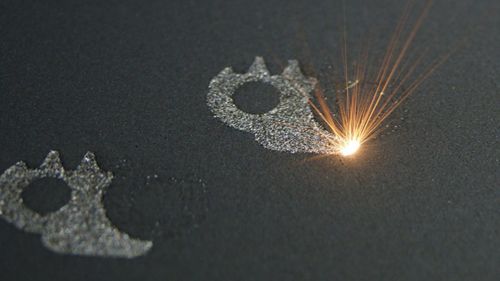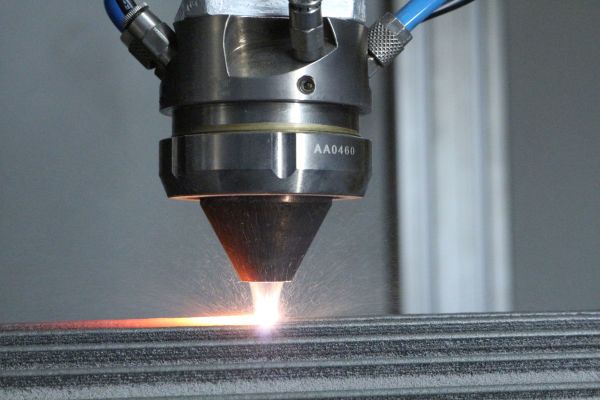
All beautiful things are based on an idea. “Let's ride without horses?”, “Let's fly like birds?”, “Let's make a super-heavy fully reusable methane rocket and fly to Mars?” ... The story described below is also based on a simple and beautiful idea: “Ah Let's print large-sized metal products from powder? " Indeed, why not? If there is a technology of layer-by-layer laser fusion (SLM) for products up to half a meter in diameter, then why not print a larger product?
The KDPV demonstrates the process of direct laser growth of products with a diameter of 2 meters from titanium. It took five years of hard work, five years of trial, error, disappointment, discarding everything, and starting from scratch to make this photo. But before we start, let's go back to the very beginning - to the Idea and try to understand what it is.
Since the advent of the first 3D printing technologies from polymers, people have dreamed of the possibility of using metals. The implementation was not long in coming - with the development of powerful lasers, it became possible to selectively sinter metal powders, and the Selective Laser Sintering (SLS) technology was born. The power and quality of laser radiation grew, their cost fell, and in the mid-90s, the technical ability to melt metal powders into a solid product appeared, and the Selective Laser Melting (SLM) technology appeared. The essence of the method is simple - we pour a thin layer of metal powder, run over it with focused laser radiation, which melts the powder particles, leaves the fused "tracks", lower the construction platform and repeat the process. So, layer by layer, a product of the required geometry is created.

At the moment, this is the most mastered, studied and widely used technology of 3D printing from metal. Hundreds of equipment manufacturing companies, thousands of implementation cases, a large scientific community, certification, materials science and so on. But as they say, there is a problem (and not just one) - is it possible to make large products? The main scaling problem is that this technology requires a build field completely filled with powder. It is the size of the field that limits the size of the product. Currently, large SLM installations have a field size of up to 400x400x400 mm (EOS M400) or 500x280x365mm (SLM500), but there are more, but this is a topic for a separate article. And if you want more? And if you want a productivity not of 100 g / h, but at least 1 kg / h, so that a product of a couple of hundred kilograms does not print for six months? Then you need to change your approach.

Let's take a laser technological head - a device for focusing laser radiation, such as are used, for example, for laser welding, add a powder supply nozzle to it, which will supply powder from a special feeder and hang everything on some manipulator. Laser radiation is focused by the head into a spot a couple of millimeters in size, it is absorbed by the substrate metal, and energy is spent on creating a pool of molten metal - like a weld pool in conventional welding. Now we will supply metal powder to this bath, it will be captured by the melt after cooling, it will form a weld bead. The process is similar to conventional welding with an additive - arc, gas, laser, whatever.
And now we will lay the rollers on top of each other along a certain trajectory and form a product from these rollers. It's that simple!
Spoiler
No.
The technology did not work out only with the name. For some reason, all the developers decided to give their unique name: the first were Optomec with their Laser Engeneered Net Shaping, then Irepa Laser with their Construction Laser Additive Directe, then the names Laser Metal Deposition, Direct Metal Deposition, Direct Metal Tooling, Blown-Powder Direct Energy Deposition and many others. In Russian, the terminology is even more fun (for example, tracing paper such as direct laser deposition), so our name is Direct Laser Growing.
Five years ago, our journey from watching a video of the BeAM Machines company on YouTube, now we create equipment and develop technologies for making beautiful, large blanks and everything looks like this:

And the products look like this:

What is the most interesting part?
It is possible to produce large workpieces in hours - days pass from the approval of the 3D model to the finished part. Material properties are at the level of rental standards. The size of the product is limited only by the customer's courage (and his greed). You can make quite complex products, although the complexity of geometric shapes does not compare with the possibility of SLM, but they are in different leagues. It is possible to make bimetallic and gradient products by combining different powders. It is possible to customize the installation, adapting it to the requirements of the product.
And so the most common additive technology, for the development of which it took:
- Design a technology tool from scratch six times
- Throw out and create an automatic control system from scratch seven times
- Learn to program B&R PLCs and be aware of all previous pain
- Make friends with Fanuka technical support. Hello Vladimir Maisky!
- Re-invent sealed cabins
- Engage in technical espionage
- Suffer for a long time when creating control programs, look for a solution, find it and catch the euphoria. Hello Alexander Ragulin!
- Realizing dozens of times that the more you do technology, the less you understand it
- Finally realize your own limitations, come to terms with it and believe in the processes
- Gather the best team and learn to work wonders
If it was interesting - write in the comments, what to devote to the next article? Technology? Physics of the process? Iron? Control system? Creation of control programs? Or an overview of what is being done in the world using this technology and why are all machines different and which one is better?